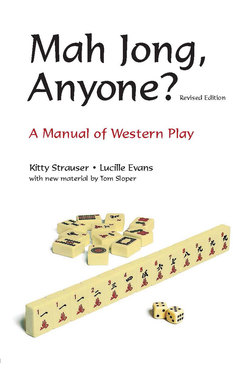Читать книгу Mah Jong, Anyone? - Kitty Strauser - Страница 6
На сайте Литреса книга снята с продажи.
ОглавлениеPreface
You are a beginner and you have a Mah Jong set. Or perhaps you are thinking of buying one. In either case, this is your book, designed to help you know your set and to get the most enjoyment out of the game. If you are an old hand, you will find in this volume much of what you already know, simply stated and easily referenced, plus a comprehensive list of the most played special hands.
As Mah Jong fans for many years, we have played a wide range of systems and methods in the United States and many parts of the Far East. Based on our experience, observation, and study, three points stand out sharply:
1. Mah Jong, because of its basic simplicity and adaptability, is eternally appealing to all age groups. Initial curiosity is undoubtedly aroused by its exotic equipment, seemingly ritualistic methods of play, or possibly its ancient and curious origins and history, of which there are many versions. But its persistent popularity is due to its unlimited variety in play; its continuing development of fresh, new hands; and, most of all, the challenge of mastering these.
2. As skill and knowledge develop, it soon becomes apparent that there are almost as many ways to play aside from the original basic game as there are players.
3. There is a need for a concise description of the game most widely played in English-speaking countries, not only to instruct the beginner, but also to serve as a reference for seasoned players. And that is the purpose of this manual.
For the sake of brevity we have omitted the history and background of Mah Jong and also descriptions of the numerous Asian variants because most Western players seem to prefer the excitement and stimulus of the wider-ranging adaptations that they themselves have brought to this absorbing game.
To claim completeness or ultimate authority in any field is to open the door to unending trouble. Therefore we point out that Chapters 1–4 of this manual represent a sincere attempt to set forth for beginners this modern method of playing Mah Jong and to give a detailed description of its equipment, terminology, rules, penalties, and scoring. In Chapter 5, for experienced players as well as novices, brief descriptions of the best-known special hands are listed. An entirely new section on strategy rounds out the book.
Mah Jong is primarily a game for four persons, and the instructions in this manual are given for that number. Two-, three-, five-, and six-handed games are possible although rarely played. However, two-and three-handed games are described briefly on pages 44–45.
You will inevitably discover new hands as soon as you start spending your days at Mah Jong. It is impossible to play Mah Jong without constantly learning something new, and that is the secret of its fascination.
